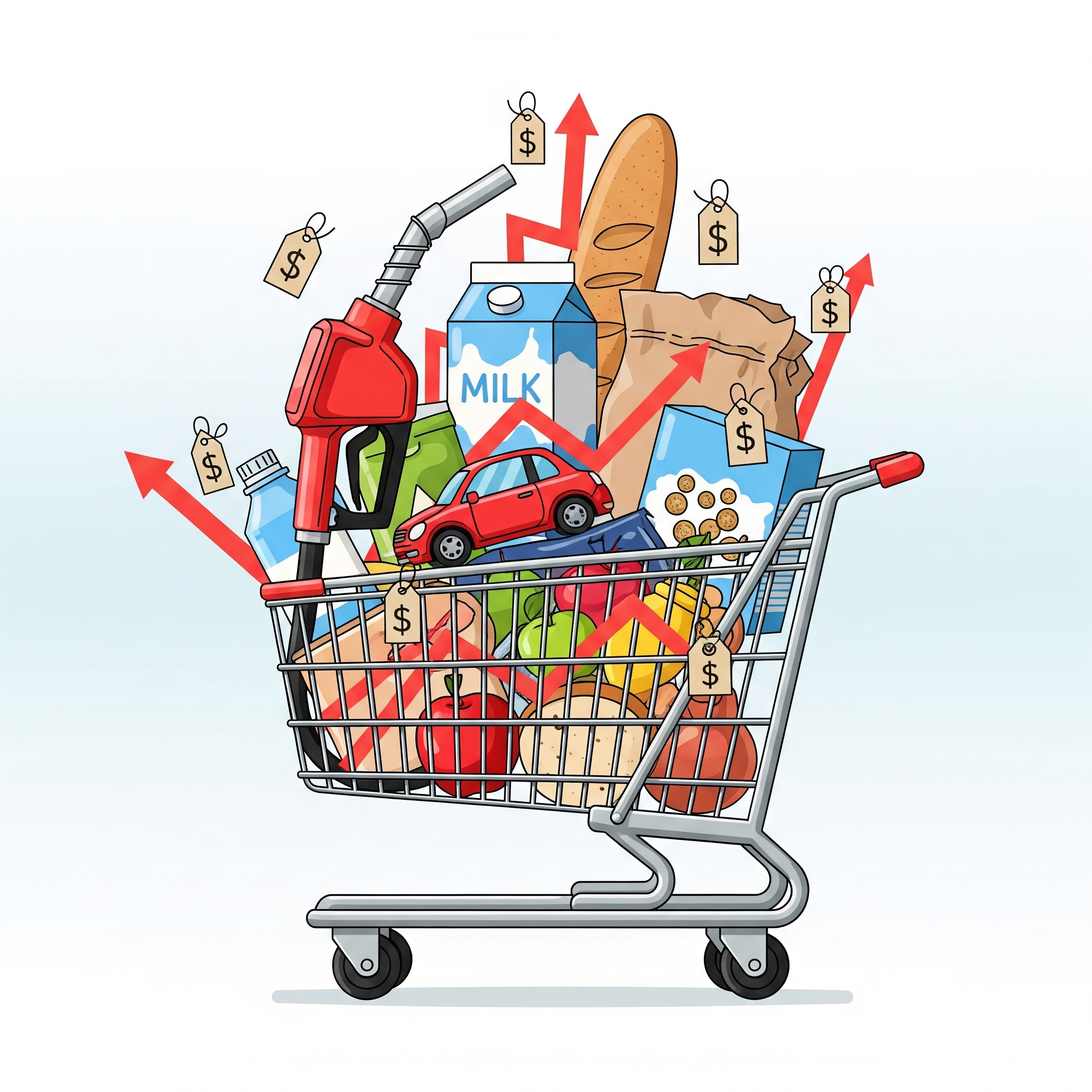Understanding Inflation: How Different Products Affect Perception of Price Increases
Inflation is the general increase in prices across an economy, resulting in decreased purchasing power of money. Purchasing power refers to the amount of goods or services that one unit of currency can buy. Let’s explore how inflation impacts consumer perceptions differently depending on the type of products involved.
Key Concepts Defined
- Inflation: A sustained rise in the general price level of goods and services in an economy.
- Purchasing Power: The amount of goods or services that can be purchased with a unit of currency.
- Consumer Perception: How consumers view and emotionally respond to changes in prices or market conditions.
Frequent Purchases: Gasoline vs. Milk
Products purchased frequently, such as gasoline and milk, significantly influence consumer perceptions of inflation. Gasoline prices are highly visible; drivers notice these prices daily, and even small fluctuations create immediate emotional responses. For example, if gasoline prices rise from $3.00 to $3.60 per gallon, consumers immediately notice the 20% increase, especially when refueling weekly.
Milk prices, although regularly purchased, tend to fluctuate less dramatically. A rise from $3.00 to $3.30 per gallon represents a smaller 10% increase, which, when spread across weekly grocery trips, seems less significant. While noticeable, milk typically represents a smaller portion of the overall budget compared to gasoline, reducing its psychological impact.
Large Purchases: Homes vs. Cars
Inflation also influences consumer perceptions differently based on the size and frequency of purchases. Real estate prices have a substantial emotional and financial impact because buying a home is often the largest financial commitment people undertake. For example, a 5% increase in home prices from $300,000 to $315,000 equates to an additional $15,000, significantly impacting affordability and financial planning.
In comparison, vehicles—though expensive—typically represent smaller financial commitments than homes. A similar 5% increase in the price of a $30,000 car amounts to an extra $1,500. While this increase may cause frustration, its overall emotional and financial burden is substantially less than with housing.
Visibility and Attention: Game Systems vs. Appliances
Consumer perception of inflation is further influenced by marketing visibility and media attention. For example, new gaming consoles receive significant marketing and media coverage, making price increases highly noticeable. If a gaming console priced at $400 increases by 10% to $440, it attracts immediate consumer attention, particularly among enthusiasts.
On the other hand, appliances typically receive less public attention. A similar 10% increase in the price of a refrigerator, from $1,000 to $1,100, although financially meaningful, often goes relatively unnoticed because of the limited media exposure.
Why This Matters
Recognizing these distinctions highlights that inflation affects different sectors of the economy in unique ways. Factors such as frequency of purchase, size of expenditure, and level of consumer engagement shape how price changes influence consumer sentiment and financial behavior.
Inflation, at its core, represents the general increase in prices and the consequent decrease in the purchasing power of money. For freshman economics students, understanding inflation involves more than just definitions; it’s essential to grasp how inflation impacts consumers differently based on what they’re buying. Let’s break down how various types of products affect consumer perceptions and feelings about inflation.
Frequent Purchases: Gasoline vs. Milk
Products purchased frequently, such as gasoline and milk, significantly influence how consumers perceive inflation. Gasoline prices are highly visible; drivers see these prices daily, and even small fluctuations create immediate emotional responses. For example, if gasoline prices rise from $3.00 to $3.60 per gallon, consumers immediately notice the 20% increase, especially if they fill up weekly.
On the other hand, milk prices, though regularly purchased, tend to fluctuate less dramatically. A rise from $3.00 to $3.30 per gallon represents a smaller 10% increase, which, spread over weekly grocery purchases, may seem less significant. Consumers may notice milk price changes, but since milk represents a smaller overall portion of their budget compared to gasoline, the psychological impact tends to be less intense.
Large Purchases: Homes vs. Cars
When prices rise on larger, less frequent purchases like homes or vehicles, the consumer response shifts significantly. Real estate prices are particularly impactful because purchasing a home is usually the most substantial financial commitment a consumer makes. For instance, a 5% increase in home prices from $300,000 to $315,000 represents an additional $15,000, significantly affecting affordability and leading to heightened stress or financial anxiety.
In comparison, cars—while still expensive—typically cost significantly less than homes. A similar 5% increase on a $30,000 car results in an extra $1,500. Consumers might feel annoyed or inconvenienced by higher car prices but the emotional and financial burden is substantially smaller than with housing.
Visibility and Attention: Game Systems vs. Appliances
Interestingly, consumer perception of inflation is also influenced by marketing visibility and media attention. Take game systems versus home appliances, for example. New gaming consoles receive extensive marketing and media coverage, making any price increases highly noticeable. A gaming console priced at $400 increasing by 10% to $440 attracts immediate attention and discussion, especially among younger or enthusiastic consumers.
Appliances, on the other hand, rarely receive the same level of attention or emotional engagement. A similar 10% increase in a refrigerator’s price, from $1,000 to $1,100, although financially meaningful, is less noticeable to the general consumer because it’s not constantly discussed or highlighted in the media.
Why This Matters
Understanding these distinctions helps economics students grasp that inflation isn’t felt uniformly across all sectors of the economy. Frequent visibility, scale of purchase, and consumer engagement level all influence how inflation affects consumer sentiment. Awareness of these nuances can lead to better economic decision-making and policy considerations as you progress in your economics education.


Leave a Reply